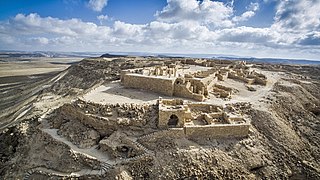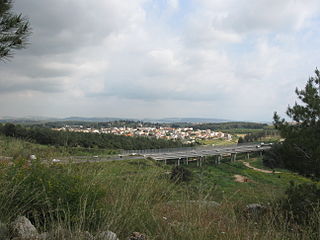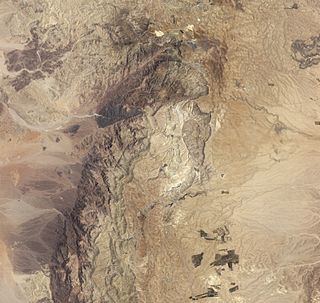Related Research Articles
Golan is the name of a biblical town later known from the works of Josephus and Eusebius. Archaeologists localize the biblical city of Golan at Sahm el-Jaulān, a Syrian village east of Wadi ar-Ruqqad in the Daraa Governorate, where early Byzantine ruins were found. Israeli historical geographer, Zev Vilnay, tentatively identified the town Golan with the Goblana (Gaulan) of the Talmud which he thought to be the ruin ej-Jelêbîne on the Wâdy Dabûra, near the Lake of Huleh, by way of a corruption of the site's original name.

The Arabah/Araba or Aravah/Arava is a loosely defined geographic area in the Negev Desert, south of the Dead Sea basin, which forms part of the border between Israel to the west and Jordan to the east.

The archaeology of Israel is the study of the archaeology of the present-day Israel, stretching from prehistory through three millennia of documented history. The ancient Land of Israel was a geographical bridge between the political and cultural centers of Mesopotamia and Egypt.

Pella was an ancient city in what is now northwest Jordan, and contains ruins from the Neolithic, Chalcolithic, Bronze Age, Iron Age, Canaanite, Hellenistic and Islamic periods. It is located near a rich water source within the eastern foothills of the Jordan Valley, close to the modern village of Ṭabaqat Faḥl some 27 km (17 mi) south of the Sea of Galilee. The site is situated 130 km (81 mi) north of Amman: a drive of about two hours, and an hour southwest by car from Irbid, in the north of the country. Pella's ruins – predominantly temples, churches, and housing – have been partially excavated by teams of archaeologists; they attract thousands of tourists annually but especially in spring, during which time the area is awash with spring flowers.

The Eretz Israel Museum is a historical and archaeological museum in the Ramat Aviv neighborhood of Tel Aviv, Israel.

Avdat or Ovdat, and Abdah or Abde, are the modern names of an archaeological site corresponding to the ancient Nabataean, Roman and Byzantine settlement of Oboda or Eboda in the Negev desert in southern Israel. It was inhabited with intermissions between the 3rd century BCE and the mid-7th century CE by Nabataeans, in their time becoming the most important city on the Incense Route after Petra, then by Roman army veterans, and Byzantines, surviving only for a few years into the Early Muslim period. Avdat was a seasonal camping ground for Nabataean caravans travelling along the early Petra–Gaza road in the 3rd – late 2nd century BCE. The city's original name was changed in honor of Nabataean King Obodas I, who, according to tradition, was revered as a deity and was buried there.

The Timna Valley is located in southern Israel in the southwestern Arava/Arabah, approximately 30 kilometres (19 mi) north of the Gulf of Aqaba and the city of Eilat. The area is rich in copper ore and has been mined since the 5th millennium BCE. During early antiquity, the area would have been part of the Kingdom of Edom.

Umm ar-Rasas, ancient name: Kastron Mefa'a, is located 30 km southeast of Madaba in the Amman Governorate in central Jordan. It was once accessible by branches of the King's Highway, and is situated in the semi-arid steppe region of the Jordanian Desert. The site has been associated with the biblical settlement of Mephaat mentioned in the Book of Jeremiah. The Roman military utilized the site as a strategic garrison, but it was later converted and inhabited by Christian and Islamic communities. In 2004, the site was inscribed as a UNESCO World Heritage Site, and is valued by archaeologists for its extensive ruins dating to the Roman, Byzantine, and early Muslim periods. The Franciscan academic society in Jerusalem, Studium Biblicum Franciscanum (SBF), carried out excavations at the north end of the site in 1986, but much of the area remains buried under debris.

Al-Khalasa, was a Palestinian village, located 23 kilometers southwest of the town of Beersheba. The village stood at the site of an ancient town from the Nabatean, Roman, Byzantine, and the beginning of the Early Muslim period. The ancient city, founded by the Nabateans, is known from Greek and Roman sources as "Halasa" or "Chellous", and later as "Elusa", one of the Byzantine administrative centers in the Negev Desert. Still important in the century of the Muslim conquest, it was deserted not long after. The site was repopulated by Bedouin in the early twentieth century, after western archaeologists took an interest in it. In October 1948, it was captured by Israel during the 1948 Arab-Israeli War. The population of al-Khalasa is unknown, but all of the inhabitants were Muslims, from the al-Azizma tribe.

Meiser is an Arab village in northern Israel. Located half a kilometre west of the Green Line, north of the city of Baqa al-Gharbiyye in the triangle area of Wadi Ara, it is one of three Arab villages under the jurisdiction of Menashe Regional Council. In 2022 it had a population of 2,115.

Khirbet en-Nahas, also spelled Khirbat en-Nahas, is one of the largest copper mining and smelting sites of the ancient world, built around 3,000 years ago. It is located in Wadi Faynan, between the Dead Sea and the Gulf of Aqaba, now in Jordan. There is evidence of sophisticated economic and political activity in the valley about 3,000 years ago and archaeologists think it may be the site of an early organized state.

Umm Qais, also known as Qays, is a town in northern Jordan principally known for its proximity to the ruins of the ancient Gadara. It is the largest city in the Bani Kinanah Department and Irbid Governorate in the extreme northwest of the country, near Jordan's borders with Israel and Syria. Today, the site is divided into three main areas: the archaeological site (Gadara), the traditional village, and the modern town of Umm Qais.
Khirbet edh-Dharih is a multi-period archaeological site which mainly flourished during the Nabataean period, when a prosperous settlement with a religious sanctuary stood there. The site is located on the King's Highway in southern Jordan, about 70 km north of the ancient Nabataean capital city, Petra, or in caravaning terms at the 3rd station from it, the nearest modern town being Tafileh. The earliest signs of human habitation at the site are from the Neolithic period and more specifically the Pottery Neolithic A (PNA) period, circa 6000-4000 BCE.

Khirbet al-Mukhayyat, also commonly known as the town of Nebo, is a village in Madaba Governorate in Jordan. The village is about 3.5 km from Mount Nebo, also known as Siyagha. Many Byzantine churches were found in the village, including the Church of Saint Lot and Saint Procopius, the church of St. George, and the al-Kaniseh Monastery located a short distance down in a valley below the hill. The town also contains material culture from a wide range of phases from the Chalcolithic to the Ottoman period including several Hellenistic features, an Iron Age fort, and a number of caves, tombs, cisterns and agricultural infrastructure.

Wadi Feynan or Wadi Faynan is a major wadi and region in southern Jordan, on the border between Tafilah Governorate and Aqaba and Ma'an Governorates. It originates in the southern Jordanian Highlands with the confluence of Wadi Dana and Wadi Ghuweyr, and drains into the Dead Sea via Wadi Araba.

Udhruh, also spelled Adhruh, is a town in southern Jordan, administratively part of the Ma'an Governorate. It is located 15 kilometers (9.3 mi) east of Petra. It is the center of the Udhruh Subdistrict. In 2015, the town had a population of 1,700 and the subdistrict had a population of 8,374.
Khirbat Nuqayb al-Asaymir is a Middle Islamic period archaeological site located at Faynan, southern Jordan. The site contains smelting workshops, dwellings, watchtowers, and administration areas. The study of the site began in early 20th century and has continued to the present. After a survey in 2002, artifacts including pottery and coins were discovered at the site, which date the occupation of the site to Middle Islamic-period and give interpretations of the activities and economics at KNA in the past.
Ashalim is one of four metallurgical sites investigated by Ezra Ben-Yosef in his 2008 study of the Arabah Valley. His attempt to place the four copper production sites in a chrono-cultural context using archaeomagnetic dating was noted for its metallurgical significance.
Tel Masos is an archaeological site in Israel, in northern Negev, about 15 kilometres southeast of Beer-Sheva, along the Beer-Sheva River. It is actually a cluster of different sites scattered around the wells in the area.
The Negev region, situated in the southern part of present-day Israel, has a long and varied history that spans thousands of years. Despite being predominantly a semi-desert or desert, it has historically almost continually been used as farmland, pastureland, and an economically significant transit area.
References
- 1 2 3 4 Novo, Alexandre; Vincent, Matthew L.; Levy, Thomas E. (2012-08-29). "Geophysical Surveys at Khirbat Faynan, an Ancient Mound Site in Southern Jordan". International Journal of Geophysics. 2012: 1–8. doi: 10.1155/2012/432823 . ISSN 1687-885X.
- ↑ Megan A. Perry et al., Condemned to Metallum?: Illuminating Life at the Byzantine Mining Camp at Phaeno in Jordan, in Bioarchaeology and Behavior, University Press of Florida, October 2012, ISBN 9780813042299
- 1 2 3 4 5 6 7 8 9 "Wadi Faynan, Copper Mine". World Archaeology. No. 13. 2005-09-07. Retrieved 2019-01-14.
- ↑ Ward, Lauren (2012-05-29). "Excavations at the Site of an Ancient Techno-Revolution". National Geographic. Archived from the original on June 13, 2012. Retrieved 2017-01-09.
- 1 2 "The Kingdom of Copper". ArcGIS StoryMaps. Retrieved 2020-07-16.
- ↑ Gwiazda, Mariusz (2022), "Burial practices in early Byzantine Syro-Palestine (4th–7th centuries CE) – review article", Polish Archaeology in the Mediterranean, 31: 296, 302, doi: 10.37343/uw.2083-537X.pam31.01
- ↑ The History of the Martyrs in Palestine, Eusebius of Caesarea, translated by William Cureton (1861)
- ↑ History of the Arians, Athanasius of Alexandria, translated by M. Atkinson and Archibald Robertson. From Nicene and Post-Nicene Fathers, Second Series, Vol. 4. Edited by Philip Schaff and Henry Wace. (Buffalo, NY: Christian Literature Publishing Co., 1892.)
- ↑ Watkins, Basil (November 2015). The Book of Saints A Comprehensive Biographical Dictionary. Bloomsbury Publishing. p. 679. ISBN 9780567664150 . Retrieved 13 December 2023.
- ↑ Christensen, Torben (1989). Rufinus of Aquileia and the Historia Ecclesiastica, Lib. VIII-IX, of Eusebius. Kongelige Danske videnskabernes selskab. p. 104. ISBN 87-7304-178-5 . Retrieved 13 December 2023.
- ↑ Frend, W. H. C. (April 2014). Martyrdom and Persecution in the Early Church A Study of Conflict from the Maccabees to Donatus. Wipf & Stock Publishers. p. 537. ISBN 9781625648044 . Retrieved 13 December 2023.